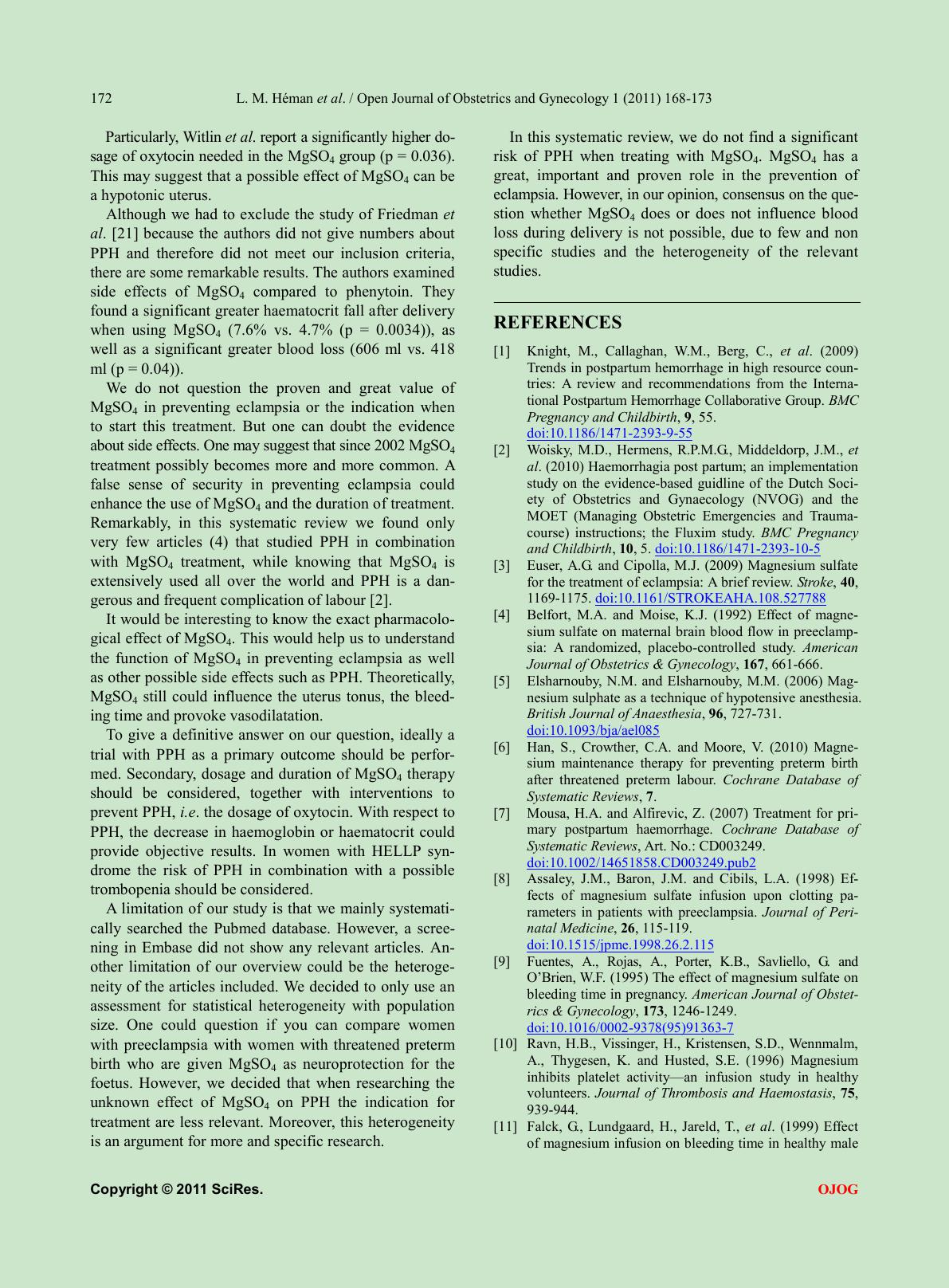
L. M. Héman et al. / Open Journal of Obstetrics and Gynecology 1 (2011) 168-173
Copyright © 2011 Sci Re s. OJOG
Partic u lar l y, Witlin e t a l. report a significantly higher do-
sage of ox ytoci n needed in the MgSO4 gro up (p = 0.036).
Thi s may s ugge st t hat a po ssib le e ffect of M gS O4 can be
a hypotonic uterus.
Altho ugh we had to exclude the study of Friedman et
al. [21] because the authors did not give numbers about
PPH and therefore did not meet our inclusion criteria,
there are some remarkable results. The authors examined
side effects of MgSO4 compared to phenytoin. They
found a significant greater haematocrit fall after delivery
when using MgSO4 (7.6% vs. 4.7% (p = 0.0034)), as
well as a significant greater blood loss (606 ml vs. 418
ml (p = 0.04)).
We do not question the proven and great value of
MgSO4 in preventing eclampsia or the indication when
to start this treatment. But one can doubt the evidence
about side effects. One may suggest that since 2002 MgSO4
treatment possibly becomes more and more common. A
false sense of security in preventing eclampsia could
enha nce t he u se o f M gS O4 and the duration of treatment.
Remarkably, in this systematic review we found only
very few articles (4) that studied PPH in combination
with MgSO4 treatment, while knowing that MgSO4 is
extensively used all over the world and PPH is a dan-
gerous and frequent complication of labour [2].
It would be interesti ng to kno w the exact p harmacolo-
gical effect of MgSO4. This would help us to understand
the function of MgSO4 in preventing eclampsia as well
as other possible side effects such as PPH. Theoretically,
MgSO4 still could influence the uterus tonus, the bleed-
ing time and provoke vasodilatation.
To give a definitive answer on our question, ideally a
trial with PPH as a primary outcome should be perfo r-
med. Secondary, dosage and duration of MgSO4 therapy
should be considered, together with interventions to
pre vent P PH , i.e. the dosage of oxytocin. With respect to
PPH, the decrease in haemoglobin or haematocrit could
provide objective results. In women with HELLP syn-
drome the risk of PPH in combination with a possible
trombopenia should be considered.
A limitation of our study is that we mainly systemati-
cally searched the Pubmed database. However, a scree-
ning in Embase did not show any relevant articles. An-
other limitation of our overview could be the heteroge-
neity of the articles included. We d ecided to only use an
assessment for statistical heterogeneity with population
size. One could question if you can compare women
with preeclampsia with women with threatened preterm
birth who are given MgSO4 as neuroprotection for the
foetus. However, we decided that when researching the
unknown effect of MgSO4 on PPH the indication for
treatment are less relevant. Moreover, this heterogeneity
is an argument for more and specific research.
In this systematic review, we do not find a significant
risk of PPH when treating with MgSO4. MgSO4 has a
great, important and proven role in the prevention of
ecla mpsia . Ho wever, in our opinion, conse nsus o n the que -
stion whether MgSO4 does or does not influence blood
loss during delivery is not possible, due to few and non
specific studies and the heterogeneity of the relevant
studies.
REFERENCES
[1] Knight, M., Callaghan, W.M., Berg, C., et al. (2009)
Trends in postpartum hemorrhage in high resource coun-
tries: A review and recommendations from the Interna-
tional Postpartum Hemorrhage Collaborative Group. BMC
Pre gnanc y and Childbirth, 9, 55.
doi:10.1186/1471-2393-9-55
[2] Woisky, M.D., Hermens, R.P.M.G., Middeldorp, J.M., et
al. (2010) Haemorrhagia post partum; an implementation
study on the evidence-based guidline of the Dutch Soci-
ety of Obstetrics and Gynaecology (NVOG) and the
MOET (Managing Obstetric Emergencies and Trauma-
course) instructions; the Fluxim study. BMC Pregnancy
and Childbirth, 10, 5. doi:10.1186/1471-2393-10-5
[3] Euser, A.G. and Cipolla, M.J. (2009) Magnesium sulfate
for the t reatmen t o f eclampsi a: A brief revie w. Stroke, 40,
1169-1175. doi:10.1161/STROKEAHA.108.527788
[4] Belfort, M.A. and Moise, K.J. (1992) Effect of magne-
sium sulfate on maternal brain blood flow in preeclamp-
sia: A randomized, placebo-controlled study. American
Journal of Obstetrics & Gynecology, 167, 661-666.
[5] Elsharnouby, N.M. and El sh arnouby, M.M. (2006) Mag-
nesium sulphate as a technique of hypotensive anesthesia.
British Journal of Anaesthesia, 96, 727-731.
doi:10.1093/bja/ael085
[6] Han, S., Crowther, C.A. and Moore, V. (2010) Magne-
sium maintenance therapy for preventing preterm birth
after threatened preterm labour. Cochrane Database of
Systematic Reviews, 7.
[7] Mousa, H.A. and Alfirevic, Z. (2007) Treatment for pri-
mary postpartum haemorrhage. Cochrane Database of
Systema tic Reviews, Art. No.: CD003249.
doi:10.1002 /14651858.CD003249.pub2
[8] Assaley, J.M., Baron, J.M. and Cibils, L.A. (1998) Ef-
fects of magnesium sulfate infusion upon clotting pa-
rameters in patients with preeclampsia. Journal of Peri-
natal Medicine, 26, 115-119.
doi:10.1515/jpme.1998.26.2.115
[9] Fuentes, A., Rojas, A., Porter, K.B., Savliello, G. and
O’Brien, W.F. (1995) The effect of magnes ium sulfate o n
bleeding time in pregnancy. American Journal of Obstet-
rics & Gynecolog y, 173, 1246-1249.
doi:10.1016 /0002-9378(95)91363-7
[10] Ravn, H.B., Vissinger, H., Kristensen, S.D., Wennmalm,
A., Thygesen, K. and Husted, S.E. (1996) Magnesium
inhibits platelet activity—an infusion study in healthy
volunteers. Journal of Thrombosis and Haemostasis, 75,
939-944.
[11] Falck, G., Lundgaard, H., Jareld, T., et al. (1999) Effect
of magnesium infusion on bleeding time in healthy male